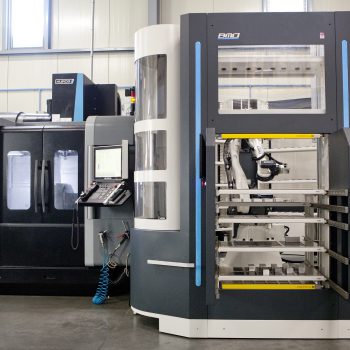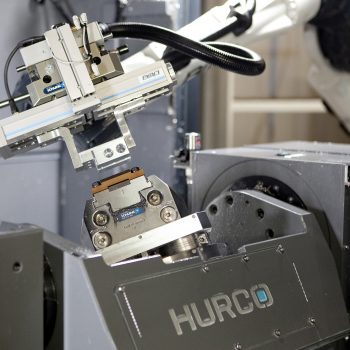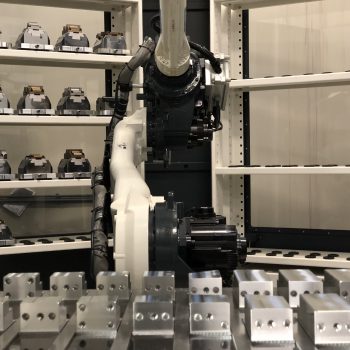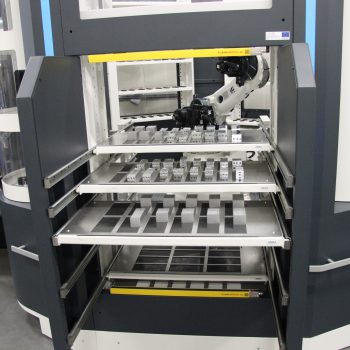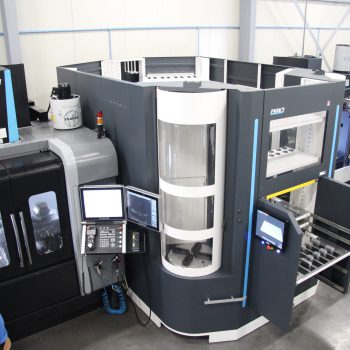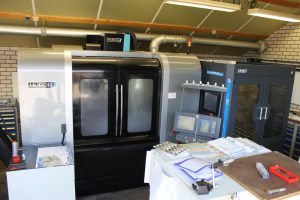Hurco VMX30Ui onto a Titanium 50
Milling 4.0: a logistical process
When fine-mechanical companies transform their processes at the machine into a logistics process, they gain more than just capacity. This can be done by zooming in on every step of the machining process and putting the knowledge into databases. In this way, you can leave much more work in production to logistics staff. That way you increase the production that comes from the machines and you suffer less from the lack of professionals, says Frank Biemans.
Getech controls the BMO robot cell directly from the ERP system without human intervention.
Automation has entered a new phase, says Frank Biemans, director of BMO Automation, the Dutch manufacturer and supplier of automation solutions for loading and unloading CNC turning and milling machines. At Getech in Westerbork, manufacturer of measuring setups for the automotive industry, BMO Automation recently completed an automation project that he believes is trend-setting. A Hurco and a Doosan CNC machine as well as a Titanium 50 robot cell from BMO Automation, produce fully autonomous 60 unique products in one night, finished on six sides. The BMO robot automation is controlled from the ERP system. “These are truly unique products that Getech has never made before. So no repeat orders”, emphasizes Frank Biemans. In less than a minute, the robot cell has read the data from the ERP system for all 60 products and programmed the robot. Thanks to BMO Automation’s unique self-adjusting gripper and the high capacity of pallet spaces for machine clamps, for example, no one has to adjust anything mechanically at the machine anymore. “This is a good example of automating single pieces with product handling. The products have never been machined on the machine before and they are machined on six sides”.
Innovation
In the 13 years of BMO Automation’s existence, Frank Biemans sees a shift in automation. In the beginning it was mainly about automating larger series and replacing hands; today automation is becoming more high quality and more complex. “Our focus has remained the same all these years, but thanks to the further development of our products, we are now able to handle 10 times 1 product. And that’s what it’s all about. Manufacturing companies are confronted with high mix low volume and more and more make-to-order. Shifting knowledge to work preparation and automation systems helps to process that order flow efficiently. The BMO Automation software team has created an interface between the robot cell and the ERP system for Getech. This allows production to be fully controlled from the ERP system. Even the robot does not need to be programmed, that data comes from the ERP system. The company has implemented the necessary standardization in the production itself. The robot cell itself has special software modules, such as BMO’s Tool Lifetime Management module. The system knows whether the tool life is still sufficient for the jobs being loaded and warns if this is not the case. In the unlikely event that a tool breaks, the control system uses it intelligence and looks for orders that can still be processed if no sister tool is available. The specific milling knowledge, the milling strategies, are also stored in a database.
BMO Automation built the automation system for Getech in such a way that the robot cell is controlled from the customer’s ERP system. Programming the robot for 60 unique products is done automatically in less than a minute.
The future starts today
To make this all possible, it is important that companies standardize. Frank Biemans: “Take the process apart and minimize the risks for each step”. Any business can start today. Standardization of tooling, CADCAM programs and working with tool management systems are things you can start implementing right away. This lays the foundation for a logistics process in the factory. According to Frank Biemans, if you succeed in shifting a lot more work towards work preparation and optimising the process in such a way that only logistic work remains on the machine, you create an enormous capacity. “The potential capacity in the Netherlands would be enormous if all companies were to do this. Millers then become process engineers, taking any uncertainty out of the process. Repeat orders then automatically go to the machine; the robot sets the machine to this order. The use of AGVs to automate logistics work can be a next step that Frank Biemans believes will certainly come. First and foremost, however, is process control. This forms the basis for the automation of machining processes. “If you have properly controlled all parts of the process and eliminated risks, you don’t have to control every product. Process control is crucial.”
Servogripper 2.0: no mechanical adjustment
An important part of the total automation solution of BMO Automation is the self-developed self-adjusting gripper. Version 2.0 was recently launched. This self-adjusting gripper adjusts itself to the dimensions of the product or the clamp. The new gripper has an even wider range (up to a maximum of 274 mm), is waterproof, is available in a two- and three-point version as well as a combination of these. This is practical, for example, for the multitasking machines where you start with bar material and take a prismatic part out of the machine. Partly thanks to the self-adjusting gripper, a BMO robot load cell changes jobs within a minute without the need for mechanical changeovers. As a result, considerable time advantages can be achieved and the capacity of the CNC machine increases considerably.
Click here for technical specifications about the Hurco VMX30Ui.




